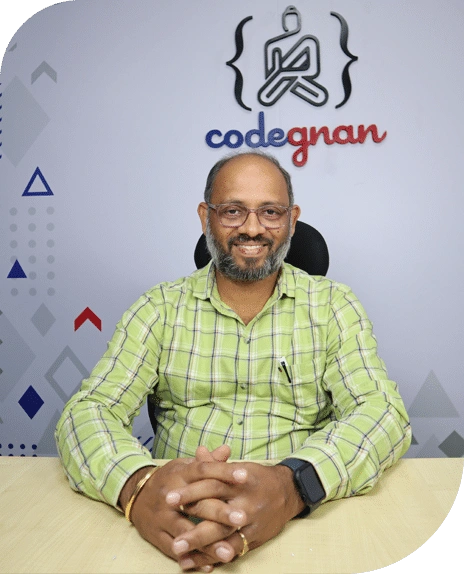Full Stack Java Training Course In Hyderabad With Placement for 2023/24 passouts
Full stack development is one of the highest-paying jobs even amongst the programming languages. Java Full stack, in particular over the past 50 years, is the most popular one as it has so far powered over 3 billion devices.
So, if you are planning to get a Java full-stack developer course in Hyderabad, codegnan has you covered. Why trust us? We trained more than 30,000 students worldwide and are rated 4.8 out of 5 by 2180+ students on Google. Plus, our job acceleration program ensures 100% job placement.
- English
- 100 Days
- 50,000
Become a full stack java developer
Talk to our expert Java mentors and learn how our training programs in Hyderabad can help you become a Java developer and get a high-paying job.
300 Hours Instructor
Led Training
Self-Paced
Videos
Exercises
& Projects
Authorized
Certification
Flexible
Schedule
Lifetime Access
& Upgrade
24/7 Lifetime
Support
Java training course overview and key features
By getting trained as a full-stack developer, you’ll be able to provide solutions for an entire design structure, including both front and back end.
Apart from being a comprehensive course with placement assurance, here are some highlights of the course:
1.Learn with Live Projects
You'll apply your Java full-stack skills on real-world projects, gaining practical experience that goes beyond theory.
2. Choose Between Offline or Online Training
You have the flexibility to pick either in-person or online classes, making it convenient for your learning style.
3. 24/7 Student Support
Whenever you need assistance or have questions, there will be support available around the clock to help you.
4. Job and Interview Assistance Post Course Completion
You'll receive guidance and support in your job search and interview preparation, increasing your chances of landing a great job in the field.
5. Flexible Schedule
The course offers a schedule that adapts to your needs, allowing you to balance your studies with other commitments.
6. Expert Tutors
Your instructors come from prestigious tech companies and institutes like IIT Bombay, IIT Jodhpur, Amazon, Google, Microsoft, and Stanford University. They bring top-tier knowledge and expertise to your learning experience.
Career growth with Java training course in Hyderabad
A Java full-stack training can help you establish your career as a full-stack developer. The average salary of a full stack developer in Hyderabad is around ₹ 8.5 LPA. However, it can range anywhere between ₹2.0 to ₹ 15.0 LPA depending on various factors. Therefore, needless to say, pay-wise, it is one of the well sought-after jobs.
But apart from that, here are some more reasons why a Java training course is a good career growth move.
1. Versatility in Software Development
Java full-stack equips you with the skills to work on both front-end and back-end development, making you a well-rounded developer capable of creating entire web applications.

2. High Demand
The job market highly values full-stack developers proficient in Java, as they are capable of handling various aspects of web development.

3. Diverse Career Opportunities
Completing a Java full-stack course broadens your job prospects, including roles like web developer, software engineer, or even technical lead, offering diverse and rewarding career paths.

Full Stack Java developer course curriculum in Hyderabad
- History
- Features
- Post Install Configuration
- Writing a simple program
- compiling and executing
- Data types
- Variables and Arrays
- Using Eclipse
- Create packaged classes
- Eclipse shortcuts
- Arithmetic Operators
- Boolean Operators
- Logical Operators
- Binary Operators
- Branching Statements
- Iterative Statements
- Break & Continue with enhancements
- While
- For
- Do..While
- Break and Continue Statement
- Basics of OOPs
- Fundamentals of class & object
- new keyword
- Reference variables
- Member methods of a class
- Constructors
- Finalize method
- Overloading member methods
- Overloading constructors
- Passing and returning objects with methods
- Access Control
- Static Methods
- Static Variables
- Static Block
- Using final keyword
- Unit Testing using Junit-5
- Basics of Inheritance
- Members accessibility in inheritance
- Using super keyword
- The sequence of execution of constructors in inheritance
- Method Overriding
- Dynamic Method Dispatch
- Abstract classes
- Preventing overriding
- Preventing inheritance
- Fundamentals of Exceptions
- Types of exceptions
- Using try and catch keywords
- Multiple catches
- Nesting of try blocks
- Using throw keyword
- Using throws keyword
- Finally block
- Some predefined exceptions and their usage
- User defined exceptions
- Purpose of Interface
- Defining an interface
- Implementing interfaces
- Interface reference variables
- Interface with variables
- Extending interfaces
- Basics of threads
- Java threaded model
- Defining threads using Runnable interface
- Defining threads using Thread superclass
- Multiple threads
- Thread Priority values
- Thread Synchronization using synchronized methods
Thread Synchronization using synchronized blocks
- Using String class
- Using java.lang package
- Working with Data & Time
- Utility framework
- Collection framework
- I/O framework
● Solving Level by Level Challenges
● Assignments to acquire Bronze and Silver Level badges
- Introduction to Database & DBMS
- Data types
- Table, Record, Field
- SQL Queries,
- Database Normalization
- Joins, Sub Queries
- INSERT UPDATE | DELETE Operations
- DDL Commands
- PL/Sql
- Overview of JDBC API
- Different types of JDBC Drivers
- JDBC URLS
- DriverManager
- Establishing a connection with the database
- Creating and executing SQL Statements
- Working with CallableStatement
- Definition
- Deploying a simple servlet in a Servlet Container (Tomcat)
- Life cycle of a Servlet
- Servlet interface
- ServletRequest Interface
- ServletResponse Interface
- Additional capabilities of HTTPServlet
- Servlet Programming with JDBC CRUD Operations
- Session tracking
- JSP Basics
- Differences between Servlets and JSPs
- Running a simple JSP
- The JSP generated Servlet code
- JSP Implicit Objects
- JSP Syntax for Different JSP Elements
- Developing JSP Beans
- Introduction to ORM, JPA
- SessionFactory, Session, Transaction
- Performing CRUD Operations with XML
- Performing CRUD Operations with Annotations
- Different ID Generation Strategies
- Hibernate with Inheritance
- Introduction
- BeanFactory and application Context
- Container Concepts
- Spring Data JPA Template
- AOP
- MVC
- Introduction to STS
- DI with STS
- MVC, AOP
- Security, Role based Authentication, OAuth2, Token based authentication
- Introduction to WebServicer
- Basics of REST APIs
- MVC, AOP
- Spring REST
- Introduction to MicroService architecture
- Advantages with MicroService over Monolithinc architecture
- Develop and Deploy Microservice application in localhost Introduction to Service Discovery
- Client side Discovery pattern
- Server side Discovery pattern
- Load Balancing configuration
- Introduction to DevOps and advantages
- Cit
- Maven
- Jenkins
- Docker
- Unit Testing with JUnit
- Creational Design Patterns
- Structural Design Patterns
- Miscellaneous Design Patterns
- Behavioral Design Patterns
Life Line – A Health Assistance Web Application Requirement description
- Patient portfolio service- Health records (medical checkup history), book a bed (hospital), compare the cost of beds, compare Test reports, order medicines Doctor (service) -find doctor, book an appointment, doctor details
- Hospital (service) – list of doctors, specialty, available beds, book outdoor appoint- ment, treatment package(pregnancy, heart surgery etc.)
- Pathology (service) – list of tests, details about each test, book an appointment, test results/current and history)
- Medical Store (Service) – search Medicines, order medicines, upload prescriptions. view order history
- Ambulance service – Find Ambulance, Get travel cost. Book a travel, View travel history
Requirement description
- To provide computerised data storage facilities
- Users can search easily for any record.
- The new system requires less time for completion of any work.
- All the stock of medicine is updated automatically in the new system.
- Integration of Payment Gateway
- The system is user friendly and anyone having computer knowledge can handle it easily.
- Maintaining stock, Supplier information, Customer information & bill information are easy.
Requirement description
- Develop a web based application auctions. This application allows the users to sell something in auctions.
- Users of the application bid on the products they are interested in buying.
- The main objective of the e-Auction must be to obtain best value and the highest price.
- It cannot be possible to achieve best value outcomes whilst the focus remains on price.
Requirement description
An online-banking application allows you to perform day to day banking activities.
- New User Registration
- Login
- Deposit
- Withdrawal
- Fund Transfer
- Introduction
- History and Importance of HTML
- Basic HTML syntax
- The current state of HTML
- HTML resources
- Choosing a code editor
- Exploring an HTML document
- DOCTYPE declarations
- Document head
- Understanding content models
- Formatting content with HTML
- Headings
- Paragraphs
- Whitespaces
- Images
- Unordered lists
- Ordered lists
- Definition lists
- Anchor element
- Page internal linking
- Linking to external pages
- Linking to downloadable
- Linking to page regions
- Introduction to forms and their importance
- Form structure and basic form elements
- Text inputs, textareas, and buttons
- Radio buttons and checkboxes
- Select dropdowns and file uploads
- Hidden inputs and labels
1. Favourite Blog
2. Resume building with HTML
3. Registration & Login page
Getting started
- HTML overview
- Default browser styles
- Browser support and inconsistencies
- Inline, internal and external CSS
- Naming conventions
- Syntax, terminology, and naming conventions
- Type, class, and id selectors.
- Combinator selectors
- Selectors: Best practices
- Web-safe fonts and the font-family property
- Web fonts and Google fonts
- The font-size property
- The font-style and font-weight properties
- The color, line height, and text properties
- Adjusting the font-weight property
- Block vs. inline display
- The box model
- Margin and page layout
- Padding
- Floats
- The box model fix
- Box model review
- Float and display review
- Horizontal navs with the display property
- Horizontal navs with the float property
- Positioning
- Float, display, and position
- Layers and the z-index property
- CSS grid
- CSS Flexbox
1. Building Paytm clone Page
2.Building Portfolio page
- Introduction
- What is Bootstrap? Why do we use it?
- Initial environment setup
- Section introduction
- Headings and basic typography
- Text alignment and Display
- Floats and Fixed positions
- Colors and Backgrounds.
- Margin and Padding spacing
- Sizing and Borders
- Section Intro
- Buttons and Button groups
- Navbar and Navs
- List groups and Badges
- Forms & input
- Input groups
- Alerts and Progress Bars
- Tables and Pagination
- Working with cards
- Media objects
- Jumbotron
- Section Intro
- Grid system
- Grid alignment
- Flexbox classes
- Auto margin, wrap, and ordering
- Introduction
- What is JavaScript?
- How does JavaScript relate to Java?
- History of JavaScript
- Navigating the JavaScript landscape
- Tools for JavaScript development
- Introducing the browser console
- Add inline JavaScript to an HTML document
- Add JavaScript in an external file
- Basic syntax & comments
- Declarations
- Arithmetic operators and math operators
- Working with strings and numbers
- Literals
- Conditional statements and logic
- Looping Statements
- Arrays
- Predefined functions of an Array
- Defining functions
- Calling functions
- Closures
- Arguments & parameters
- Arrow functions
- Number Methods
- Boolean Methods
- String Methods
- Array Methods
- Math Methods
- RegExp Methods
- Creating objects
- Objects and properties
- Map
- Exporting
- Importing
- Default exports
- Renaming features
- Aggregating modules
- Dynamic module loading
- Intro to DOM
- Target elements in the DOM with querySelector methods
- Access and change classes
- Access and change attributes
- Add DOM elements
- Apply inline CSS to an element
- DOM events
- AJAX calls
- get, post, put, delete using fetch() and axios library
1. Creating a website in which we can upload files, displaying data in table format, and adding CSS to it from the front end.
2.Creating a simple College website using HTML, CSS, JS. In which we can move from one page to another page, building a registration page.
- Introduction to React.js
- Setting up a React development environment (e.g., Nodejs, npm, Create React App)
- Hello World example
- Understanding React components
- JSX syntax
- Functional components
Class components
Passing and using props
- State in React components
- Updating state
- Component lifecycle methods
- useState()
- useEffect()
- useContext)
- Event handling in React
- Binding event handlers
- Arrow functions vs. regular functions
- Controlled components
- Handling form submission
- Form validation
- Conditional rendering with if statements
- Ternary operators and logical && in J5X
- Rendering Lists
- Using map to render lists of elements
- Providing a key for each item
- The importance of keys in React
- Choosing the correct key
- CSS in React
- Different approaches for styling (CSS, CSS-in-JS, CSS Modules)
- Inline styles
- Styling Libraries
- Popular CSS frameworks (eg, Bootstrap, Material-Ul)
- Introduction to React Router
- Setting up React Router
- Creating routes
- Navigating with React Router
- Using Link and NavLink
- Nested Routes and Dynamic Routing
- Nested routes
- Passing parameters to routes
- Introduction to Redux
- Understanding the need for state management
- Basic concepts: actions, reducers, store
- Setting Up Redux
- Installing Redux and setting up a store
- Creating actions and reducers
- Connecting React with Redux
- Using connect to connect components to the store
- Dispatching actions
- Making HTTP requests in React
- Fetching data from an API
- Async/Await and Promises
- Error Handling and Debugging
- Debugging React apps
- Performance Optimization
- Memoization
- React.memo and PureComponent
1) Hospital Management System:- It is a single Page application. In which doctors and patients are available. Using ReactJS, json-server package.
Doctors are going to be added based on their Specialisation
Patients are going to book appointments for a Specific Doctor.
2) Online Banking Application:- A simple online-banking application allows you to perform day to day banking activities.
New User Registration
Login
Deposit
Withdrawal
Fund Transfer
Deploying a React application
• Deployment strategies (e.g., Netlify, Vercel, AWS)
Java Skills Covered in Hyderabad.
After completing codegnan’s Java Full Stack training in Hyderabad, here are the skills you will develop.
Java basics: from writing simple programs to getting introduced to DevOps tools and design patterns, learn everything in the Java introduction.
Front-end development: It starts with basic HTML syntax and takes you to make advanced layouts using CSS grid and CSS Flexbox.
Java Script: Learn what is- Java Script, control flow, arrays, functions, objects, essential Java script built-in methods, DOM, and Java script Server actions.
ReactJs: Learn the basics of ReactJs to Handling errors in React applications.
Become a full stack java developer
Talk to our expert Java mentors and learn how our training programs in Hyderabad can help you become a Java developer and get a high-paying job.
Technologies and Frameworks you will learn with Our Full Stack Java training in Hyderabad
The quality of your learning highly depends on what tools you have been able to master. Here are some of the languages, tools, and platforms you will be trained on throughout the course.
1.My SQL
It's a language that helps you communicate with databases, allowing you to store, retrieve, and manage data efficiently.

2. Core Java
The backbone of Java development, teaching you the essential coding skills needed for building applications.

3. J2EE
Think of it as a toolbox for creating enterprise-level Java applications to build robust and scalable systems.

4. HTML and CSS
These are like the paint and canvas for web development. HTML structures your content and CSS styles it to create beautiful web pages.


Full Stack Java Projects you will work on
To apply the learnings codegnan gives you four live project options to work on. These projects not only help you understand where you stand but also add weight to your portfolio.
Here’s a sneak peek of some of the hands on project you will work:
1.A Healthline Assistance Web Application
In this project, you will learn to set up an app that can do authentication and authorization, and handle relevant services related to patient portfolio, doctors, hospitals, medical stores, and ambulances.

2. Online Medicine Shopping System
You will learn how to integrate features like computerized data storage, automatic updates of warehouse stock reports, payment gateway, and so on.

3. Online Auction Application
Develop a web-based auction application that allows users to sell something in auctions. Learn to add the feature of live bidding on products.

4. Online Banking Application
Build an online banking app that performs day to day banking activities. Like, registering new users, and helping them make deposits, withdrawals and fund transfers.


Who is This Java Full Stack Course For?
If you are skeptical about whether this course is the right fit for you or not, let’s clarify your doubts. According to codegnan experts, here are the ideal audience profiles for this training.
1.College Students/Fresh Graduates
For those starting their career journey, a Java full stack course provides a solid foundation and boosts career. It can help land entry-level positions as web developers, giving them a head start in the tech industry.

2. Beginner Developers
If you're new to programming, this course is a great stepping stone. It equips you with comprehensive skills, making it easier to secure your first job as a developer.

3. IT Professionals
For those in IT looking to enhance their skill set, a Java full-stack course offers the opportunity to pivot into web development roles, expanding career prospects within the tech industry.

4. Anyone Interested in Java Full Stack:
This course also welcomes enthusiasts with a passion for web development.


Full Stack Java Certification in Hyderabad
Wondering how will you prove your expertise when interviewing? Then don’t worry, as our Java Full Stack course in Hyderabad comes with a certification.
After successfully completing the course; you will receive an authorized certification of compilation from codegnan to prove your authenticity.

Meet Your Full Stack Java course Trainers
Kishor Kumar
A Tech-expert with 20+years of industrial experience with 360 degrees expertise in Java Full Stack. Trained employees on latest frameworks as per the project requirements in JP Morgan Chase, TCS, HSBC, Covalense Digital, DBS Bank, Capgemini, DXC Technologies, Guardian Life, UST Global, Wipro, CSC India and many more.

Codegnan Learners success
1250+ Companies Have Hired Codegnan Learners









Full Stack Java Course Fees in Hyderabad— Get 30% off
The price of codegnan’s JAVA Full Stack online and offline training with numerous placement drive opportunities at just ₹ 50,000 against the original price of ₹ 70,000. Despite already being a steal deal, we must mention that apart from the training, this course also offers assured job placement assistance and lifetime access to learning materials and updates. Which increases the value of the training manyfold.
However, we do understand that budget can be a constraint for a few. So for them, we can arrange up to a 30% discount, dropping the effective price to ₹50,000 only (only for limited students and time).
Our other full-stack Java training location(s)
codegnan's other training courses in Hyderabad
Phone Number
Location
Kothwal Madhava Reddy Plaza, Beside Indian Oil Petrol Bunk, JNTUH Metro Station, Nizampet X Roads, Hyderabad - 500072
Full Stack Java Training in Hyderabad FAQs
1. Is Java full stack a good career in 2023?
Yes, Java full stack is an excellent career choice in 2023. The demand for skilled Java full-stack developers is still high, as Javascript is still the most popular programming, scripting, and markup language.
2. What are the eligibility criteria to enroll in this course?
To be eligible for codegnan’s Java training, you have to be at least a school graduate (passed 12th boards). Other than that there are no such criteria.
3. What are the full-stack Java training fees offered by codegnan?
The regular price for both online and offline Java training by codegnan is ₹70,000. But with discounts and offers, you can get it at only ₹50,000.
4. What certification will I receive upon completion of the course?
Upon completion of the course, you will receive a codegnan-authorized certification with all your achievements.
5. What are the job opportunities after this full-stack Java training from codegnan?
After completing this full-stack Java training from codegnan some of the job opportunities that you can easily land would be web developer, full-stack developer, java developer, technical lead, UI/UX developer, and quality assurance engineer.
6. Does learning Java increase my salary?
Yes, learning Java can increase your salary. Java is a popular programming language that is used in a wide variety of industries, so there is a high demand for Java developers.
7. Can I learn Java full stack in 3 months?
Yes, you can learn Java full-stack in 3 months. Infact codegnan’s Java training duration is 100 days, including live projects. So, if you have targeted to learn Java full stack in three months, this course will be the perfect pick for you.
8. What is the course duration of this full-stack Java training in Hyderabad?
The course duration of the full-stack Java training in Hyderabad is 100 days.
9. Does codegnan offer online and offline full-stack Java training classes in Hyderabad?
Yes, codegnan does offer both online and offline full-stack Java training classes in Hyderabad. The schedules are also flexible so you can easily pick a time even if you have a full-time job to manage alongside.
10. What if I have queries after the course?
We will assist you in case of any queries, even after the completion of your Java online training. You are always welcome to reach through our customer care number or email us your query. We would love to assist you.
11. What is meant by 24*7 lifetime support?
You will get 24*7 support and lifetime access to the LMS, where course material like presentations, installation guides & class recordings are available. Email support will always be there to clear your doubts.














